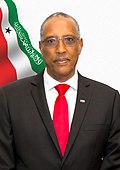 |
|---|
This is a list of presidents of the Republic of Somaliland, a de facto sovereign state in the Horn of Africa, considered internationally to be part of Somalia. The Republic of Somaliland regards itself as the successor state to British Somaliland, which was independent for a few days in 1960 as the State of Somaliland. [1] [2] The President of Somaliland is the head of state and head of government of Somaliland. The president leads the executive branch of the Government of Somaliland and is the commander-in-chief of the Somaliland Armed Forces. The official residence of the president is the Presidential Palace in Hargeisa.







